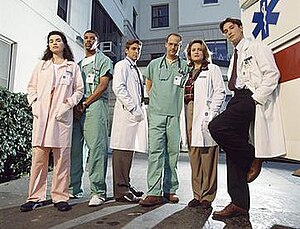I have been pondering nursing’s attitudes towards and interactions with the media, especially the news media—within the context of advocacy. Advocacy at its simplest is speaking up, “to plead the cause of another.” Public policy advocacy “rests on a three-legged stool; to be effective, all three legs must be in place.” (Nancy Amidei, So You Want to Make a Difference: Advocacy is the Key, OMB Watch, 2010) The three legs of advocacy are: 1) the capitol leg (anywhere the laws and policies are made), 2) the community, grassroots leg, and 3) the media leg (anything we do to spread the word/influence more people). In general, nurses do not do well at any of these three legs, but probably do worst with the media leg. Why?
Nurses know advocacy at the individual patient level. Nurses as the fearless defenders of patients is an image deeply rooted in nursing history. Florence Nightingale and Nurse Hawthorne are cut from the same cloth. When nurses are shown in a positive light in the popular media, it is usually as patient advocate superhero. People resonate with that role for nurses, and it is a nursing role modeled for new nurses and included in their basic education. Many nurse leaders maintain that patient advocacy is the exclusive purview of nursing, as if nurses have to protect patients from doctors, social workers, and hospitals. Taken too far, it can be a paternalistic and anti-teamwork frame of mind.
Nurses know advocacy at the self-interest level, through professional nursing organization policy platforms, and through nurse lobby and collective bargaining groups. Nurse patient staffing ratios, expanded scope of practice for nurses, and longer uninterrupted breaks for hospital nurses (see “The Nurse Lobby Day that Wasn’t” blog post, 2-15-11). In addition, much of nursing research is self-interested advocacy of various aspects of the nursing role.
Nurses don’t know public (political) policy advocacy—for the most part. Public health nurses have more experience in and knowledge of this area than do other nurses. They have to, since they work within the socio-political determinates of health. Elite nurse leaders know and use public policy advocacy, and there are a few advanced nursing degrees in public policy advocacy. But elite nurse leaders and public health nurses make up a small fraction of the nursing workforce in our country. They are also viewed as zealots and crazies by many nurses: public health nurses are bleeding-heart progressives, and nurse leaders are out of touch with ‘real nursing.’
So what prevents more nurses from being involved in public policy advocacy? Some people maintain that it stems from nursing school socialization into a risk-averse, conflict-averse role for nurses. Being an advocate of any type—but especially of public policy—means sticking your neck out, taking risks, and dealing with conflict. Other people point out that many front line nurses are overworked and are largely powerless employees of a hierarchical hospital system—and these factors contribute to the lack of policy advocacy involvement by more nurses. And then there is the lack of education for nurses on policy advocacy, and a lack of role models and “best practices.” I teach a public policy and politics of health care graduate nursing class, but my own education and background for this came from my public health involvement, and not from nursing. The National Health Care for the Homeless annual conference I attend always has hands-on training sessions on working with the media in policy advocacy. The American Public Health Association annual conferences generally have many sessions on working with the media and other aspects of influencing public health policy. I have never heard of any such sessions at a national nursing conference.
Working with the media is essential for good policy advocacy because, as Amidei writes, “politicians pay attention to the media (it provides a way to check the community pulse); media can be used to reach other voters; and misinformation that appears in the media needs to be challenged.” Many front line nurses are afraid of interactions with the news media, of speaking out on issues affecting their work—for good reason—since they can be fired for doing so if they haven’t gone through approved channels, or if they say something negative about their workplace. Most hospitals now have policies for all employees on interacting with the media, and even on use of social networking media. This level of institutional control and intimidation has always been present, but has accelerated with the advent of hospital ratings and increased competition for business.
I was reminded of the contradictory messages given to nurses about interacting with the media in the panel discussion this past May in the aftermath of the suicide of Kim Hiatt. One of the panel members, Joanne Silburner, a longtime NPR health policy reporter, encouraged nurses to speak up more—to get to know trustworthy news reporters and to tell them their stories. I imagine that there were at least a few nurses present who did just that—or who first talked with their nurse managers who supported them in talking with the media. They are all my heroes.
Nurses already have many of the essential tools for being an effective public policy advocate. They know firsthand how power is wielded, how people are motivated, and how those with power are influenced. They see these every day in their work. With some additional Civics 101 and media- savviness brush-up—and some good modeling from a seasoned public policy advocate—they are on their way. There are some wonderful nurse policy advocates. One who comes to mind is Ruth Lubic, founder of the Family Health and Birth Center in Washington, DC. We need more. I do not presume to be a seasoned public policy advocate—but I know one. Not a nurse—a social worker. I’m having lunch with her tomorrow and hope to cook up some ideas for advocating for nurse policy advocacy, including how to work with the media.


